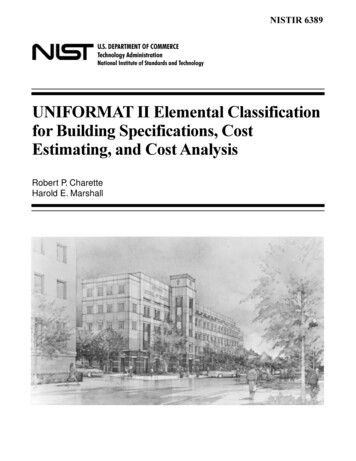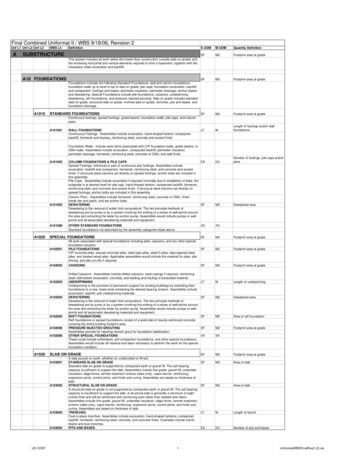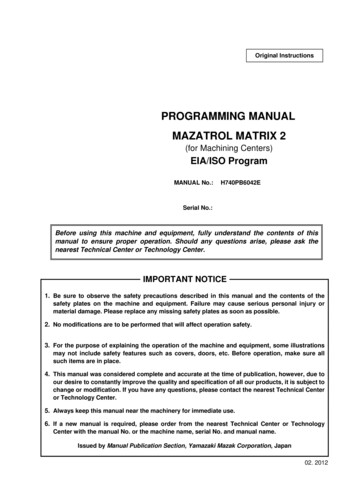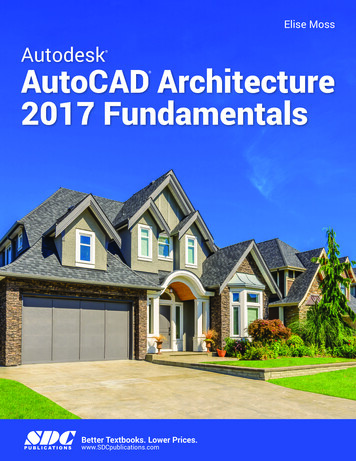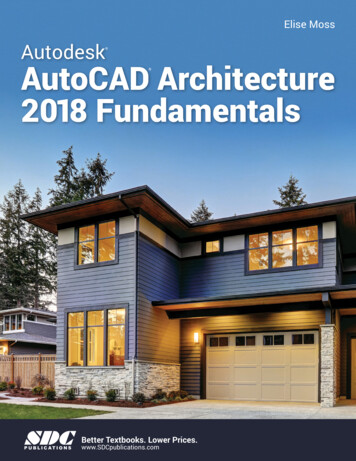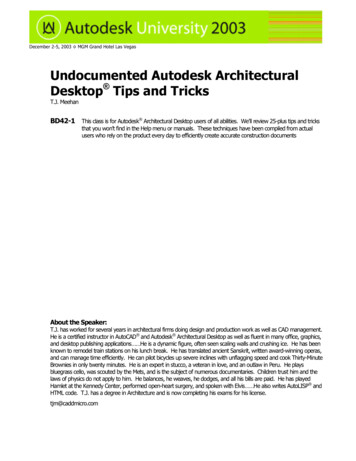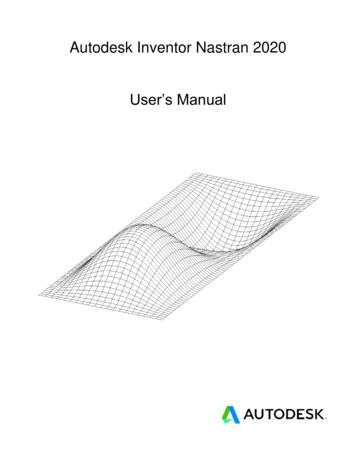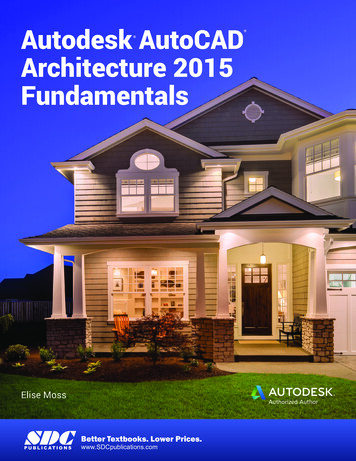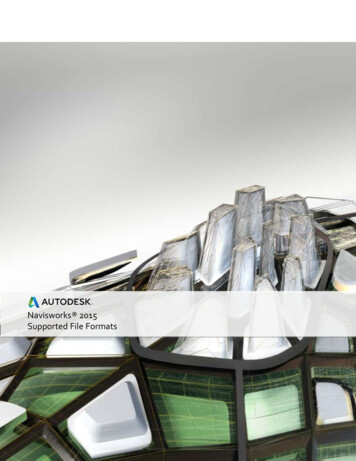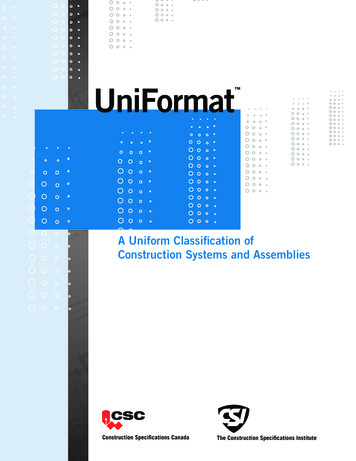
Transcription
UniFormat A Uniform Classification ofConstruction Systems and AssembliesConstruction Specifications CanadaThe Construction Specifications Institute
UniFormat A Uniform Classification of Construction Systems and Assemblies
Copyright 2010. U.S. copyright held by The Constructions Specification Institute, Alexandria, VA. Canadian copyright held byConstruction Specifications Canada, Toronto, Ontario.All rights reserved. Except as permitted under the United States Copyright Act of 1976, no part of this publication may bereproduced or distributed in any form or by any means, or stored in a database or retrieval system, without the prior writtenpermission of the publisher, The Construction Specifications Institute.For use of UniFormat numbers and titles in commercial applications, educational programs, or publications,please contact the Construction Specifications Institute at csi@csinet.org to obtain copyright license.UniFormat : A Uniform Classification of Construction Systems and AssembliesISBN 978-0-9845357-1-2 114.00 RetailCataloging-in-Publication Data is on file with the Library of CongressRobert W. Johnson, RA, FCSI Distinguished Member, CCS, CCCAJohnson and Johnson Consultants, LLCTechnical EditorCSI and CSC give acknowledgement and thanks to the members of the UniFormat Task Team for their work:Robert W. Johnson, RA, FCSI Distinguished Member, CCS, CCCA (Chair)Paul R. Bertram, Jr., FCSI, CDT, LEED APEllen Kay Crews, FCSI, CCS, CCCAPhilip W. Kabza, RA, FCSI, CCS, CCCA, AIA, SCIPGrant B. Owen, CSIJori Toniello (CSC)Andrew Wilson, CSI, CCS, CCCAMark Kalin, FCSI, CCS, FAIA, SCIP (Tech Com Liaison)Dennis J. Hall, FCSI, CCS, CCCA, FAIA, SCIP (Board Liaison)The Constructions Specification Institute110 South Union Street, Suite 100Alexandria, VA 22314800-689-2900www.csinet.orgConstruction Specifications Canada120 Carlton Street, Suite 312Toronto, ON, M5A 4K2416-777-2198www.csc-dcc.ca
TABLE OF CONTENTSINTRODUCTION1APPLICATION GUIDE5ScopeBackgroundHistoryThis EditionBasic OrganizationRelationship with MasterFormatDifferences from MasterFormatSelecting UniFormat Numbers and TitlesThe Structure Underlying UniFormatExtending UniFormat by Using MasterFormatUsing UniformatArranging Cost InformationArranging Preliminary Project DescriptionsArranging Performance Based Project ManualsOrganizing Drawings and BIM Object LibrariesArranging Facilities Management InformationArranging Construction Market InformationArranging Information for Design-Build Applications112334455677788999LEVELS ONE THROUGH THREE NUMBERS AND TITLES11MASTER LIST OF NUMBERS, TITLES, EXPLINATIONS, AND RELATEDMasterFormat NUMBERS17IntroductionElement A SubstructureElement B ShellElement C InteriorsElement D ServicesElement E Equipment and FurnishingsElement F Special Construction and DemolitionElement G SiteworkElement Z GeneralKEY WORD INDEX1925315369991111191411 i
INTRODUCTIONUniFormat is an arrangement of construction information based on physical parts of a facility calledfunctional elements1, otherwise known as systems and assemblies. These elements arecharacterized by their function without identifying the work results2 that compose them. Elementsrender a view of a constructed facility different from the view rendered by a breakdown of buildingmaterials, products, and activities that comprise work results. In this way, UniFormat complementsMasterFormat . UniFormat subdivides a facility by functional elements and MasterFormatsubdivides by work results.As an outcome of this differing view, UniFormat is able to achieve consistency in economicevaluation of existing and new projects, enhance reporting of design program information, especiallyfor preliminary project descriptions3 and performance specifications, and provide a basis forsystematic filing information for facility management, drawing details, BIM objects, and constructionmarket data. It also provides a means for the sustainable design evaluation of systems andassemblies in contrast to evaluating individual products.SCOPEUniFormat includes elements for a range of building types and construction related to buildings.Future expansions to UniFormat will include elements related to other project types in addition tobuildings. Besides elements, detailed titles are presented that provide some designed elements thatmay apply to any given element; these designed element titles are cross-referenced toMasterFormat. The term designed elements4 refers to physical parts of buildings with a particulardesign, construction, or technical solution.BACKGROUNDConstruction professionals have focused on the need to better organize project information for manyyears. The project manual concept5, 50-Division format6, and MasterFormat were developed inresponse to these challenges and have evolved through several revisions. These organizationalprinciples enhance communication within the construction industry, improve the retrieval ofconstruction information, and aid the analysis of construction information particularly during thedetailed design and construction of a project.The construction industry needed a consistent, expandable organizing concept to standardizeinformation developed in addition to those developed more explicitly for organizing constructiondocuments. This included information used to evaluate and compare alternative constructionconcepts in terms of a facility's functional parts, particularly during early design stages. There was a1Element: “Construction entity part which, in itself or in combination with other such parts, fulfils a predominating function ofthe construction entity.” International Organization for Standardization. ISO 12006-2:2001. Building construction -Organization of information about construction works -- Part 2: Framework for classification of information. Geneva,Switzerland: ISO, 2001.2Work result: “Construction result achieved in the production stage or by subsequent alteration, maintenance, or demolitionprocesses and identified by one or more of the following: the particular skill or trade involved; the construction resourcesused; the part of the construction entity which results; the temporary work or other preparatory or completion work whichresults.” Ibid.3Preliminary project description: “Written documentation for Schematic Design phase documents to provide descriptions ofthe systems and assemblies comprising the project shown in Schematic Design drawings.” Construction SpecificationsInstitute. PPDFormat: A Guide to Developing Preliminary Project Descriptions. Alexandria, VA: CSI, 2010.4Designed element: “Element for which the work results have been defined.” International Organization for Standardization.5Project manual concept is discussed in Construction Specifications Institute. Project Resource Manual. New York:McGraw-Hill, 2001. Module 5.9.1.6The 50-Division format is discussed in Construction Specifications Institute. Project Resource Manual. New York:McGraw-Hill, 2001. Module 5.5.4.2.1
UNIFORMAT – INTRODUCTIONneed for organizing documents for use in reporting the owner's program information and thedesigner’s parameters and criteria for early design stages. There is also a need for an organizationalstructure for the evaluation of completed buildings. The facility's fiscal model, owner's program, anddesigner’s parameters and criteria continue to evolve through all production phases and can beintroduced into and compared with construction documents at any phase.HISTORYConstruction information arranged according to functional building elements was first introducedoutside of the United States. Elements were included in one of five tables in a comprehensiveSwedish classification system known as "SfB." In 1947, Sweden formed a committee of 32 majorbuilding industry organizations called Samarbetskommitten for Byggnadsfr Cgor, which provided theinitials for the classification. Its first work was published in 1950 in the form of general material andwork specifications for buildings. This was a collection of codes and practices arranged according toSfB.The Royal Institute of Chartered Surveyors (UK) published a standard list of elements in 1969,Standard Form of Cost Analysis, which was reprinted in December 1995.7 The Canadian Institute ofQuantity Surveyors published Elemental Cost Analysis Method of Measurement and Pricing.8In the early 1970s, the first element-based classification in the United States was developed by theAmerican Institute of Architects (AIA) for the General Services Administration (GSA). UniFormat hassince been used by U.S. Federal agencies, RS Means, and others.In 1989, the ASTM Subcommittee on Building Economics began development of classification forbuilding elements. In 1990, the Construction Specifications Institute (CSI) became active on theworking group of this ASTM subcommittee. Other participating organizations include the AmericanAssociation of Cost Engineers, American Society of Professional Estimators, GSA, Naval FacilitiesEngineering Command, U.S. Air Force, and U.S. Army Corps of Engineers.The ASTM Working Group and DoD Tri Service Committee each prepared versions of an elementbased format in the first half of 1992. The two formats were similar but not identical. In August 1992,the National Institute of Standards and Technology (NIST) published UNIFORMAT II: ARecommended Classification for Building Elements and Related Sitework. UNIFORMAT II wasinfluenced greatly by discussions held at ASTM Working Group meetings.The first edition of UniFormat was published by CSI as an interim edition, based on the work of theASTM Working Group and the DoD Tri Service Committee. The UniFormat Interim Edition waspublished with the 1992 edition of CSI Manual of Practice and included coordination with the 1988edition of MasterFormat. This interim edition was published for trial use and comment.After the publication of NIST and CSI versions, ASTM9 balloted and accepted UNIFORMAT II in 1993as ASTM E 1557. The ASTM standard was based on NIST and DoD documents but did not include anumbering system or the low-level element classification. In 1996, ASTM adopted the numberingscheme used in CSI's UniFormat for the 1996 edition of ASTM E 1557.In 1995, CSI and CSC began revising UniFormat. Revisions were intended to align ASTM and CSIdocuments and to coordinate UniFormat with MasterFormat, 1995 edition. CSI and CSC activelysolicited public comments on the UniFormat Interim Edition and continued ongoing discussions withASTM Subcommittee E06.81 to determine the direction for the next edition.7Royal Institute of Chartered Surveyors. Standard Form of Cost Analysis. London: RICS, 1969, reprinted 1995, revised2008.8Canadian Institute of Quantity Surveyors, Elemental Cost Analysis Method of Measurement and Pricing. Toronto, Ontario,Canada: CIQS, first issued 1972, revised 1990, 2006.9Committee E6—Building Performance, Subcommittee E06.81—Building Economics.2
UNIFORMAT – INTRODUCTIONTHIS EDITIONIn 2005, a CSI/CSC task team was appointed to review the contents of UniFormat and recommendrevisions and improvements. An initial scoping and brainstorming meeting was held at the NationalInstitute of Science and Technology (NIST) headquarters in July 2006 with attendees from CSI,NIST, the ASTM subcommittee, the General Services Administration (GSA), National Institute ofBuilding Sciences (NIBS), the National Building Information Model Standard (NBIMS) ProjectCommittee, and the Naval Facilities Engineering Command (NAVFAC), among others. Outcomesfrom that meeting served to give direction to the CSI/CSC effort.Over the next five years, several additional workshops were held and three drafts for commentarywere produced. This revised edition of UniFormat is the result of decisions made in response todiscussion and commentary received.The CSI/CSC UniFormat Task Team made the following changes to this edition: Revised UniFormat to increase its usefulness for classifying information for new applicationssuch as Building Information Modeling (BIM). Changed the title of the introductory element from “Project Description” to “Introduction” andadded additional material on project criteria and owner’s development activities. Moved stairs from Category C Interiors to B Shell. Reorganized Category D Services to reflect more of a systems approach with genericfunctional categories. Provided standardized numbers for Level 4 titles throughout UniFormat. Added example performance requirements to many functional elements. Separated Related Activities from physical elements in the A Substructure and G Siteworkelements. These activities may be included with functional elements as appropriate. Placed supplementary components for many functional elements into separate categories toavoid repeating them with each functional element. The Supplementary Components areintended to be included with each functional element in that category as appropriate. MasterFormat references have been updated to the 2010 version of MasterFormat.BASIC ORGANIZATIONUniFormat classifies information into the following nine Level 1 DSERVICESEEQUIPMENT AND FURNISHINGSFGZSPECIAL CONSTRUCTION AND DEMOLITIONBUILDING SITEWORKGENERALThe nine elemental categories above can be used to arrange preliminary project descriptions, costinformation, BIM elements, facility management information, and organizing drawing details.Category Z General is designated by the last letter of the alphabet to ensure that this category willremain last no matter how the content of UniFormat may be expanded to cover additional types ofconstruction.3
UNIFORMAT – INTRODUCTIONTitles in Levels 1 through 3 can be applied to most project descriptions and preliminary costestimates. Level 4 provides a more detailed breakdown of the functional elements. Detailed listingsbelow Level 4 provide a checklist of designed elements for selection of design, construction, ortechnical solutions to allow for a more comprehensive and complete application of UniFormat.RELATIONSHIP WITH MASTERFORMATMasterFormat establishes a location for specifying element-based project information within ProjectManuals. This location is in Division 01, within 01 80 00 Performance Requirements.MasterFormat refers to UniFormat for organizing and titling elements. The two documents providecomplementary views of project information for such diverse applications as Project Manuals andcost estimating, where reference to both products and functional elements may be useful.The information in UniFormat under 30 Procurement Requirements and 40 ContractingRequirements in the Introduction is based on the MasterFormat organizational structure for thatsubject matter. The information in UniFormat under Z10 General Requirements is also based on theMasterFormat organizational structure.DIFFERENCES FROM MASTERFORMATThe primary difference between UniFormat and MasterFormat lies in how each views constructioninformation. UniFormat identifies elements, each with one or more characteristic functions. Forexample, foundations provide the function to stabilize and support. Numbered UniFormatclassifications stop above the level of defining the technical solutions used to achieve the functiondescribed. The detailed listings in UniFormat below Level 4 do provide a checklist of possibleconstruction solutions that relate to MasterFormat.By comparison, information in MasterFormat is arranged by work results, defined in MasterFormat as“permanent or temporary aspects of construction projects achieved in the production stage or bysubsequent alteration, maintenance, or demolition processes, through the application of a particularskill or trade to construction resources." This arrangement allows for more specificity in description ofthe information addressed, but also makes some of the functions served by UniFormat, such aspreliminary project descriptions, comparison of design choices, or early cost estimates, more difficultor impossible.Work results are the basic components in MasterFormat's view of construction. This viewemphasizes the perspective of the product manufacturer, supplier, detailed designer, specifier, costestimator, and contractor during the detailed design and construction phases.UniFormat, on the other hand, looks at construction the way elements are used. This perspectivecoincides with the way the user, owner, cost estimator, and designer look at construction during theearly design phases and when evaluating completed projects.This suggests using UniFormat for organizing preliminary project descriptions, cost summaries, andperformance specifications of entire elements, such as HVAC systems and exterior wall assemblies,and using MasterFormat to organize detailed cost estimates and analyses, descriptive specifications,and more detailed information about design choices made.UniFormat and MasterFormat titles suggest complementary views of construction products andperformance requirements: UniFormat names elements that have a determinable function;MasterFormat names components that have specifiable characteristics. Because constructioninformation is viewed, used, and manipulated by people with varying interests at the various stagesof the project, complementary organizational concepts are helpful.4
APPLICATION GUIDEThis application guide suggests basic strategies for numbering and titling elements for informationstorage and retrieval purposes. It is not intended to describe rigid methods for applying UniFormat but to develop the user's intuition for using this system consistently.This application guide also includes important considerations for applying UniFormat for organizingcost information, preliminary project descriptions, arranging project manuals, and organizing facilitymanagement and construction market information. Discussions are provided for understanding theunderlying structure and presentation conventions used and for selecting UniFormat numbers andtitles.SELECTING UNIFORMAT NUMBERS AND TITLESNot all UniFormat titles will be used for a given project. UniFormat is an expandable structure thatcan accommodate additional titles to meet specific requirements. However, designated numbers andtitles listed should not be changed. This helps set a consistent arrangement.UniFormat titles are generic, descriptive titles independent of the design solution. UniFormat titles arethe starting point for elements. When creating a user-defined Level 3 or 4 title, incorporate wordingfrom the parent title so the new titles are complete, clear, and descriptive.THE STRUCTURE UNDERLYING UNIFORMATThe UniFormat hierarchy comprises the major categories of construction information separated bytheir special function. These special functions include the following nine RSDSERVICESEEQUIPMENT AND FURNISHINGSFGZSPECIAL CONSTRUCTION AND DEMOLITIONBUILDING SITEWORKGENERALThe letters and titles of Level 1 categories are fixed and should not be changed in application. Thefirst category, Introduction, does, not have a letter designation. This allows it to appear first in the listof titles and distinguishes its contents from the other titles. The contents of Introduction are notbuilding systems or assemblies. Instead, it is a collection of basic information that allows users togive readers an introduction to the project before reading details of the building elements in othercategories. Introduction contains Procurement and Contracting Requirements and allows UniFormatto be used as a stand-alone contracting structure for construction projects, especially design-buildapplications.Category Z General, which also does not contain information about building systems or assemblies,is designated by the last letter of the alphabet so that the system can expand beyond buildingconstruction and allow this category to remain last.UniFormat divides Level 1 categories into classes of information by separating the categories into thediscrete concepts that compose them. Level 2 classes carry the letter of their parent category, plus atwo-digit number. Alphanumeric designations and titles of Level 2 classes are also fixed and shouldnot be changed in application.5
UNIFORMAT – APPLICATION GUIDELevels 3 and 4 are developed by further subdividing Level 2 classes. These subclasses carry thealphanumeric designation of their parent category and class, plus a two-digit number per level, withthe two-digit Level 4 numbers being set off by a decimal point as shown in the example below.Alphanumeric designations and titles of Level 3 and 4 subclasses are also fixed and should not bechanged in application. Alphanumeric designations for Level 4 that are unassigned within a group ofLevel 3 subclasses can be assigned by the user.Detailed listings below Level 4 present specialized design solutions of their parent Level 4subclasses. Particular materials may be identified (e.g., concrete and steel) to differentiate onespecialized solution from another. No standard alphanumeric designation is assigned to thesesubclasses, though extensions may be assigned by the user. The user-assigned number shouldcarry the alphanumeric designation of the parent Level 4 subclass, plus additional characters, suchas a two-digit number, an alphanumeric designator, or the corresponding MasterFormat numberseparated from the Level 4 number by an additional decimal point. The numbering system is asfollows (the “CF” appended to the Continuous Footings title below is merely one possible example ofhow to number such a title):A SUBSTRUCTUREA10 FoundationsLevel 1Level 2A1010Standard FoundationsLevel 3A1010.10Wall FoundationsLevel 4A1010.10.CF ContinuousFootingsLevel 5The numbering system can expand to allow for additional numbers and titles at any level. Should auser choose to use a variety of lower level titles beyond Level 5, the added digits should include anynumbering provided for parent subcategories similar to the way demonstrated by the upper levelnumbering. This allows UniFormat to expand in the future and allows users to add titles and numbersfor subjects not in the current edition. User-defined numbers and titles that fit within the establishedframework of UniFormat can similarly be added at any level, as long as they do not duplicate thesubject matter of any existing title or take the place of any existing number.EXTENDING UNIFORMAT BY USING MASTERFORMATSome users may want to add MasterFormat materials and methods information to a documentorganized according to UniFormat. MasterFormat numbers may be included if some materials andmethods have been determined. For example, if the building structural frame will be steel but thedesign solutions for exterior walls have not been determined, MasterFormat numbers could beincluded for B10 Superstructure but not for B20 Exterior Vertical Enclosures. Users may refinedocuments organized according to UniFormat during subsequent design phases as materials andconstruction activities are determined.The following is an example application for adding MasterFormat numbers to the UniFormatalphanumeric designations. A2010 Walls for Subgrade Enclosures is an example where the directrelationship with MasterFormat is referenced in the detailed listings below Level 4.A20 SubgradeA2010 WallsA2010.10Enclosuresfor Subgrade EnclosuresSubgrade Enclosure Wall ConstructionCast-in-Place ConcreteUnit Masonry603 30 00 Cast-in-Place Concrete04 20 00 Unit Masonry
UNIFORMAT – APPLICATION GUIDEIn the example above, a related MasterFormat number is not available until the material designationsof cast-in-place concrete and unit masonry are included. When the material to be used for SubgradeEnclosure Walls has been decided upon, a MasterFormat number can then be added after anotherdecimal point to designate the material to be used for Subgrade Enclosure Wall -Place Concrete Subgrade Enclosure Wall ConstructionUnit Masonry Subgrade Enclosure Wall ConstructionThis use of MasterFormat numbers as an extension for UniFormat is available for users who want toindicate direct relationships between the two organizational principles in the project information.The transition from project information organized according to UniFormat to one organized accordingto MasterFormat may be made easier by using MasterFormat extensions. If MasterFormat numberextensions have been added, the document organized according to UniFormat may be searched orsorted according to those MasterFormat extensions to regroup information according toMasterFormat. This may help reveal additional information, for example, a list of all elements of castin-place concrete construction in the project.USING UNIFORMATARRANGING COST INFORMATIONThe list of elements or systems serves as a basis to organize cost information. Cost information maybe reported in varying degrees of detail; as design decisions are made, the information can berefined. This arrangement of cost information allows for the comparison of various building elementsand evaluation of alternative technical solutions, particularly during early design phases. TheUniFormat cost model can evolve along with a cost model organized according to MasterFormat.These two cost models render different views of the same project and provide details appropriate fordifferent requirements. For example, a cost model organized by UniFormat can provide informationabout the cost of a concrete structure compared with a steel structure, even though there will bemore concrete or steel on the project. UniFormat provides cost comparison information for thestructural function so that the value, cost, and time scheduling of various structural solutions may beevaluated. In comparison, a cost model organized by MasterFormat can provide information aboutthe cost of all the concrete and steel on a project regardless of the structural system chosen.Value analysis requires a consistent naming scheme carried throughout the project. UniFormat isparticularly useful for value analysis, which requires attaching a cost to a particular use or facilityfunction rather than to particular products and activities. Using MasterFormat in combination withelement designations organized by UniFormat helps the value analyst evaluate value-analysischange proposals.The Related Activities categories in UniFormat may be included with the appropriate functionalelements in formulating cost information. The items under Supplementary Components categories inUniFormat should be included with the functional elements as appropriate.ARRANGING PRELIMINARY PROJECT DESCRIPTIONSPreliminary project descriptions are described in the CSI publication PPDFormat: A Guide toDeveloping Preliminary Project Descriptions. A preliminary project description helps the ownerunderstand the various components and systems proposed by the designer for the project. It alsoserves a requirement normally included in a design services agreement in which the designer mustsubmit a report after completing the schematic design before proceeding to design development.These descriptions may be supported by, and serve as a basis of, an estimate of probableconstruction costs.7
UNIFORMAT – APPLICATION GUIDEUniFormat provides a logical sequence of elements to describe a construction project before allmaterials and methods have been determined. UniFormat is used to organize, and serves as achecklist for preparing, preliminary project descriptions at various levels of detail.As the design progresses, both descriptions and the estimate of probable construction cost can berefined. Thus Preliminary Project Descriptions can be used to document the early design process asit progresses. This can begin with the determination and recording of the performance requirementsfor the various functional elements. The potential technical solutions for value analysis can then belisted. Finally the selected solution and resulting components can be added. The above steps willnot move at the same pace for the various functional elements. A Preliminary Project Descriptioncan be used to record that progress for the various functional elements so that an up-to-dateprogress report can be easily produced at any time.The Related Activities categories in UniFormat may be included with the appropriate functionalelements in preparing Preliminary Project Descriptions or they may be kept separate. The itemsunder Supplementary Components categories in UniFormat may be included with the appropriatedfunctional elements or they can be described separately.ARRANGING PERFORMANCE BASED PROJECT MANUALSArranging Project Manuals, or portions of them, according to UniFormat is appropriate whenperformance specifying is the method employed for all or some of the project. Performancespecifying can be used at many levels, from a single product to major subsystems or entire projects.It allows the owner to access a range of options, from existing technology to innovative systems anddeveloping technologies. Performance specifying encourages full bidding competition based onnonrestrictive requirements and, in its broadest application, is used for design-build projects. Whetherthe entire building or only a portion of it is specified using performance specifications, UniFormat canbe used to organize performance specifications for elements crossing MasterFormat section anddivision boundaries.The Procurement Requirements and Contracting Requirements in the Introduction may be used forperformance based contract documents. The General Requirements in Z General may be used forthe same purpose.A checklist of some performance requirements has been added to many of the functional elements inthis edition of UniFormat. These performance requirement checklists are not intended to becomprehensive or complete but to provide some examples.ORGANIZING DRAWINGS AND BIM OBJECT LIBRARIESUniFormat numbers and titles can be used as a file-naming convention for library f
UniFormat is an arrangement of construction information based on physical parts of a facility called functional elements1, otherwise known as systems and assemblies. These elements are characterized by their function without
